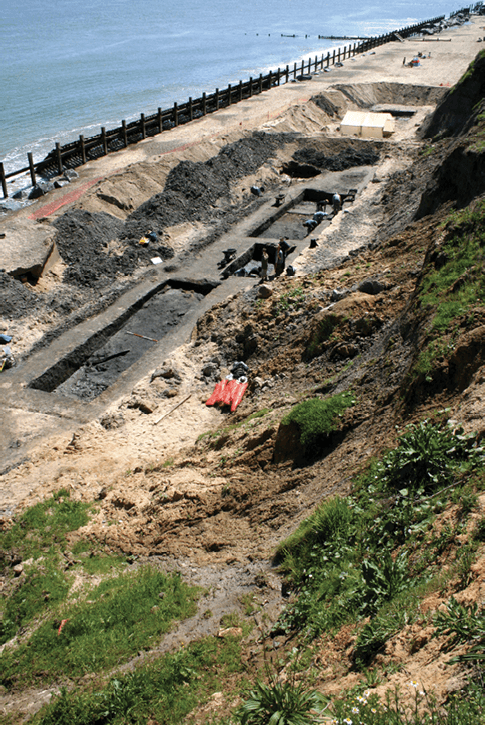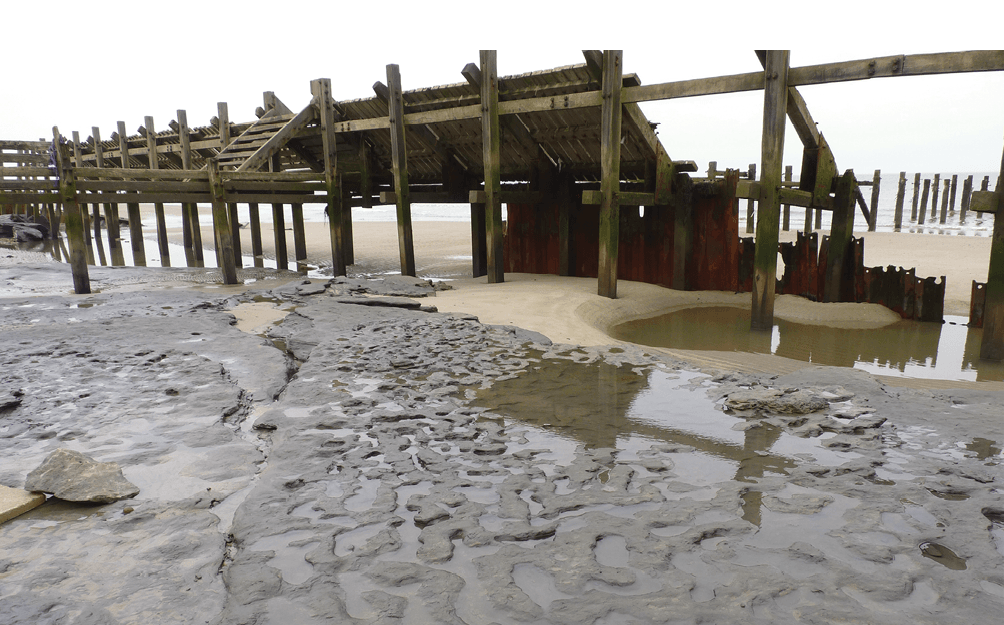Estimated reading time: 7 minutes
As with many great discoveries they were found by chance. We had been working at Happisburgh for over a decade, but visited in May 2013 to continue geophysics on the beach. It was my colleague, Dr Martin Bates, who first spotted them. Lying on ancient estuary muds, he had found the oldest footprints outside Africa, dating to at least 800,000 years ago.
Happisburgh lies on the Norfolk coast between Cromer and Great Yarmouth. The soft cliffs of clays, silts and sands have been ravaged for centuries by the sea, but this has accelerated in recent years perhaps due to the concrete defences to the north and south. As the cliffs erode back they reveal dark organic muds and gravels at their base that we call the Cromer Forest-bed. It is not a single bed, but a complex series of river and estuary deposits that were laid down over hundreds of thousands of years by eastward flowing rivers. They were eventually overlain by glacial sediments about 450,000 years ago that form the 10 m high cliffs that we see today.
For over two centuries the Cromer Forest-bed has been famous for the discoveries of fossil bones of mammoth, rhino and hippo together with fossilised wood and other plant remains, but no convincing evidence of humans. In March 2000 local resident Mike Chambers was walking his dog across a large expanse of forest-bed that was exposed at low tide. Embedded in the mud was what appeared to be a humanly worked black flint. It was in fact a handaxe.
The discovery led to extensive fieldwork initially near the site of the handaxe, but also at other exposures up and down the coast. We now have at least five sites, the youngest of which is the handaxe location of Site 1, dating to 500,000 years ago. One of the most intriguing sites lies somewhere offshore, but we have yet to discover where. We know of its existence due to large blocks of concreted gravel that contain wood, pollen, but also bone with cut-marks from human butchery. The blocks have been torn away from an offshore reef and through future survey and diving we hope to find out where.
It is Site 3 that has produced the most remarkable evidence. It lies about 1 km north-west of Site 1 and thankfully for us, slightly further up the beach and less prone to the tides. It was discovered in 2005 and consists of a complex series of river channels and estuary sediments, which preserve rich environmental remains. Pollen, wood and other plants indicate regional vegetation dominated by coniferous forest. The more localised environment can be reconstructed from study of the insect remains suggesting that the site was near the estuary of a large river with a floodplain consisting of a mosaic of grassland, stands of alder, small pools and marsh. The valley was grazed by herds of deer, horse and bison, together with larger herbivores such as mammoth, rhino and hippo.

Excavation of Happisburgh.
Site. 3 in 2010. Photo: Simon Lewis
Coniferous forest suggests cooler conditions and this is supported by the beetles. As beetles often have very specific habitats and usually fly, they are quick to react to changes in environment and from their present-day distributions can be used to reconstruct past climate. Collectively they suggest summers that were similar to East Anglia today with an average of about 17°C. But the winters were 3 – 6° cooler than today’s average of 3°C. A modern day analogue would be southern Scandinavia or northern Germany, making winters a challenge to survive.
So what of the human evidence? This comes in the form of simple sharp-edged flint tools of flakes, notches and occasional scrapers, but significantly no handaxes. There are in fact only 80 artefacts excavated from the site despite eight seasons of digging that uncovered almost 400 m2 of sediments. Importantly the artefacts come from different levels showing that humans were here for several generations.
Until May 2013 we thought this was the only human evidence, but then we discovered the footprints. Initially I was sceptical. There were a series of elongated hollows that I thought might be caused by erosion or perhaps, simply modern footprints. The latter was quickly ruled out because the sediments are compacted and are no longer soft enough to take prints. Nor were there any erosional processes that would create elongated hollows, some of which were wider at one end.
I was still not fully convinced when we recorded them using digital imagery. Despite being May the weather was foul. Battling against wind, rain and a rising tide we managed to record them, but it was only when I was sent the processed 3D model by Sarah Duffy that I realised that they really were human footprints. Analysis of the prints shows a range of sizes from adults to children. The largest were probably made by an adult male with a foot-length equivalent to a UK size 8 or 9 and indicating a height of about 5 foot 8 inches (1.73 m). It is clear that we are dealing with a family group with at least five or six individuals. They appear to have paused at the estuary edge before continuing in a southerly direction.

The footprint surface at Happisburgh site 3 in May 2013
Photo: Simon Parfitt
So what is the age of the site? The mammalian fossils provide the main clue. The mammoth remains are from an early form called Mammuthus meridionalis, which is known to have become extinct about 800,000 years ago. The horse, Equus Suessenbornensis, also became extinct about this time. By contrast an extinct giant elk, Cervalces latifrons, and red deer, Cervus elaphus, first evolved about a million years ago. The combination of these fossils means that the age of the site can be bracketed between 1 million and 800,000 years ago. This age is supported by the reversed palaeomagnetism recorded in the estuarine sediments, where minute iron minerals are orientated to the south, rather than north. The last major period of reversal ended about 800,000 years ago. Until recently it was thought that humans first reached northern Europe only 500,000 years ago. The dates for Happisburgh push this back by at least 300,000 years.
Unfortunately we have no human fossils in Britain that date to this period, but the closest site with remains is Atapuerca in northern Spain. Here we have bones and teeth from a species called Homo antecessor or ‘Pioneer Man’. From measurement of the bones we know that the average males stood about 5 foot 8 inches (1.73 m) and the females about 5 foot 3 inches (1.68 m). These heights conform with what we know from Happisburgh. They looked similar to ourselves, being fully bipedal, though with a slightly smaller brain and different cranial structure. We also know that the Atapuerca human bones have cut-marks from stone tools, indicating butchery. A rather grisly conclusion is that these people were cutting the flesh off their relatives and neighbours and were perhaps cannibals.
Questions remain about how these people survived the long, cold winters of northern Europe. One suggestion is that they seasonally migrated. But to make any appreciable difference to winter temperatures they would have had to have travelled to the shores of the Iberian Peninsula or the Mediterranean. Even for adults this would have been a difficult journey, but virtually impossible with small children or elderly relatives.
An alternative is that they had functional body hair that gave them sufficient protection from the cold. There is an elegant hypothesis that humans lost their body hair over two million years ago on the savannahs of East Africa. The argument goes that with bipedialism there was less need for protection from the sun, leading to the loss of hair, other than the scalp. One of the evolutionary advantages was better thermoregulation through more efficient sweat glands, which also enabled longer day-time hunting. This may have been the case, but there is no direct proof. It may have had advantages for Africa, but there were serious short-comings for the more seasonal climates of Europe. So perhaps humans entering Europe from Africa still had body hair or it redeveloped as they evolved in more northerly latitudes.
But maybe the simplest answer to coping with cooler climates is that they had better control of fire and were more capable of making clothes and shelters than we previously thought. Unfortunately we have no evidence for the use of these technologies at this time – we simply do not have enough sites. Better evidence for ways of buffering against the cold start to be introduced from around 500,000 years ago. At High Lodge in Suffolk we have scrapers that were ideal tools for processing hides, presumably for building simple shelters or use as clothing. From 400,000 years ago at Beeches Pit, also in Suffolk, or Menez Dregan in Brittany, we have distinct hearths from fires. By this time we are also dealing with a different human species – either Homo heidelbergensis or very early Neanderthals. Perhaps it was these more advanced species, with brains approaching the size of modern humans, who introduced these new ways of dealing with winter cold.
But to return to Happisburgh at over 800,000 years ago, perhaps the biggest challenge was the short growing season of northern latitudes. This implied a greater dependence on meat and more effective scavenging or possibly hunting. If meat acquisition was a struggle, what other resources were available? The big advantage for Happisburgh was its estuary situation, providing important resources such as collectable shellfish and seaweed over those difficult winter months. Perhaps these pioneering populations were able to cope in northern Europe, but only in coastal or estuary situations.
There are still many questions to be answered about how early humans adapted to more northern environments from the equatorial and tropical habitats in which they first evolved. The Happisburgh humans were the pioneers of the day, reaching the northernmost limit for people at that time anywhere around the globe. They were pushing the natural boundaries of the known world and dealing with new challenges, which ultimately led to the provision of food, warmth and shelter – the basic human needs that we still need today.
- Tagged:
- Happisburgh